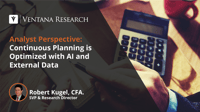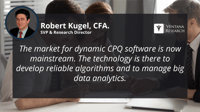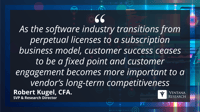The need for a COVID-19 vaccination “passport” has prompted some to suggest using blockchain technology as a means of reliably verifying an individual’s status at an international level. There are precedents: for example, until smallpox was eradicated, all international travelers were obliged to carry an immunization record for that disease on a standard paper form to gain entrance to a country. With the likelihood that COVID-19 will remain endemic for many years, a reliable digital record with...
Read More
Topics:
Data Governance,
Information Management,
Data,
blockchain
In the context of planning, budgeting and benchmarking, external data includes information about the world outside an organization such as economic and market statistics, competitors and customers. Today, a comprehensive set of external data is a “nice to have” item in most organizations, but that’s likely to change. External data is necessary for useful and accurate business-focused planning and budgeting, and for performance benchmarking. It is also essential for the effective applications of...
Read More
Topics:
Information Management,
Business Planning,
Financial Performance Management,
Predictive Planning,
AI & Machine Learning
Configure, price and quote (CPQ) software has been around for decades. Lately, I’ve been using the term “Dynamic CPQ” to apply to a variant of this software category that explicitly aims to produce a quote that optimizes the trade-off between the profitability of a deal and the probability of closing a sale. Dynamic CPQ software is a hybrid of price and revenue optimization (PRO) software and CPQ, providing companies with the ability to better execute their market share and pricing strategies....
Read More
Topics:
Customer Experience,
Office of Finance,
Data Preparation,
Information Management,
Sales Performance Management,
Financial Performance Management,
Price and Revenue Management,
robotic finance,
revenue and lease accounting,
sales enablement
By itself, data isn’t useful for business; the application of analytics is necessary to transform data into actionable information. Data analysis of one sort or another has long been a core competence of finance departments, applied to balance sheets, income statements or cash flow statements. Today, however, Finance must go beyond these basics by expanding the scope of the data being examined to include all financial and operational information that can yield actionable insights. Analysis thus...
Read More
Topics:
Customer Experience,
Human Capital Management,
Marketing,
Voice of the Customer,
business intelligence,
embedded analytics,
Learning Management,
Analytics,
Collaboration,
Data Governance,
Data Lake,
Data Preparation,
Information Management,
Internet of Things,
Contact Center,
Data,
Product Information Management,
Sales Performance Management,
Workforce Management,
Financial Performance Management,
Price and Revenue Management,
Digital Technology,
Digital Marketing,
Digital Commerce,
ERP and Continuous Accounting,
blockchain,
natural language processing,
robotic finance,
Predictive Planning,
candidate engagement,
Intelligent CX,
Conversational Computing,
Continuous Payroll,
revenue and lease accounting,
collaborative computing,
mobile computing,
Subscription Management,
agent management,
extended reality,
AI & Machine Learning
“Platform,” as used in the world of technology, originally referred to an operating system on which one could construct software applications. More recently, its usage has been expanded to apply to two types of business models. One enables third parties to create products and services that are complementary to a company’s core technology. For instance, both Apple and Salesforce have attracted a wide array of third-party software developers whose offerings greatly increase the value of each...
Read More
Topics:
Human Capital Management,
Marketing,
Office of Finance,
Voice of the Customer,
Continuous Planning,
Information Management,
Internet of Things,
Workforce Management,
Financial Performance Management,
Price and Revenue Management,
Digital Marketing,
Digital Commerce,
Operations & Supply Chain,
Enterprise Resource Planning,
ERP and Continuous Accounting,
robotic finance,
Predictive Planning,
revenue and lease accounting,
collaborative computing,
continuous supply chain
Two key themes that emerged from Larry Ellison’s Sunday night keynote at this year’s Oracle OpenWorld were faster processing speed and cheaper storage. An underlying purpose to these themes was to assert the importance of Oracle’s strategic vertical integration of hardware and software with the acquisitions of Sun. I try to view technology keynotes like this from the perspective of a practical business user. Advancements such of these are important because enhancing the performance and...
Read More
Topics:
Big Data,
Customer Experience,
executive,
Business Analytics,
Data Management,
In-Memory Computing,
Information Management,
Business Performance Management (BPM),
Business Process Management,
Data,
Financial Performance Management (FPM),
IT Performance Management (ITPM),
FPM
My colleague Mark Smith and I recently chatted with executives of Tidemark, a company in the early stages of providing business analytics for decision-makers. It has a roster of experienced executive talent and solid financial backing. There’s a strategic link with Workday that reflects a common background at the operational and investor levels. As it gets rolling, Tidemark is targeting large and very companies as customers for its cloud-based system for analyzing data. It can automate alerts...
Read More
Topics:
Big Data,
Data Warehousing,
Master Data Management,
Performance Management,
Planning,
Predictive Analytics,
GRC,
Operational Performance Management (OPM),
Budgeting,
Risk Analytics,
Analytics,
Business Analytics,
Business Collaboration,
Business Intelligence,
Business Mobility,
Cloud Computing,
Data Governance,
Data Integration,
In-Memory Computing,
Information Management,
Mobility,
Business Performance Management (BPM),
Customer Performance Management (CPM),
Financial Performance Management (FPM),
Risk,
Sales Performance Management (SPM),
Workday,
Workforce Performance Management (WPM),
Financial Performance Management,
Integrated Business Planning,
Strata+Hadoop
For the past couple of decades Xenos' distinctive competence has been the transformation of print streams into content used to assemble documents. Its focus these days is in addressing the needs of organizations that have to handle high volume transactional output (HVTO) and all forms of enterprise content. The company, which was acquired by Actuate earlier this year, recently released their Enterprise Server Version 2.0.
Read More
Topics:
Business Intelligence,
Information Management,
Content Management,
Information Management (IM)
Oracle has just released its latest (11g) version of its enterprise content management (ECM) suite. Oracle entered the ECM business mainly through the acquisition of Stellent more than three years ago. Historically, document/content management has achieved greatest penetration in paperwork heavy or highly regulated businesses such as financial services, pharmaceuticals and government as well as in specific functions such as handling web content, especially in high-volume applications. However,...
Read More
Topics:
Enterprise Content Management,
Information Management,
Oracle,
Information Management (IM),
IT Performance Management (ITPM)

















